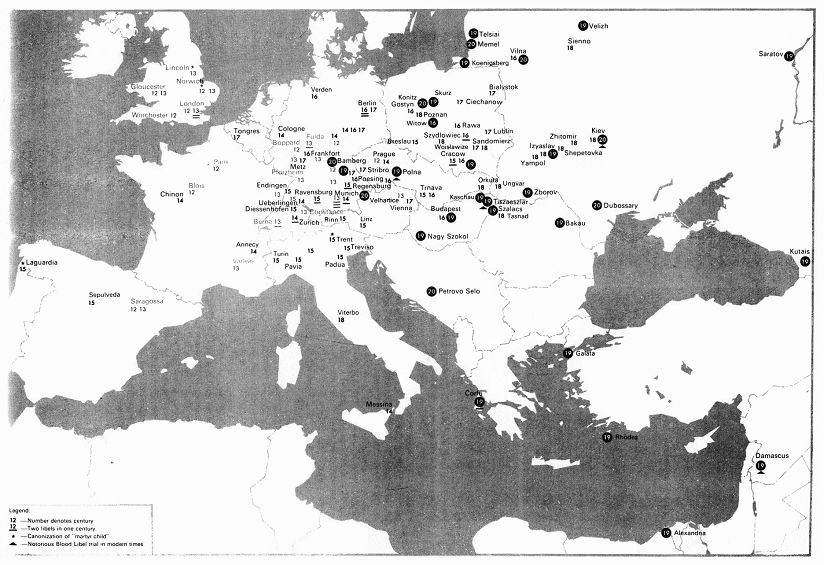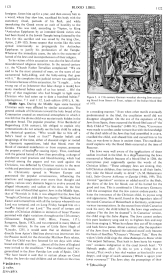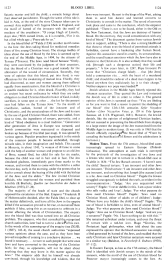<BLOOD LIBEL, the allegation that Jews murder non-Jews
especially Christians, in order to obtain blood for the
Passover or other rituals; a complex of deliberate lies,
trumped-up accusations, and popular beliefs about the
murder-lust of the Jews and their bloodthirstiness, based on
the conception that Jews hate Christianity and mankind in
general.
It is combined with the delusion that Jews are in some
way not human and must have recourse to special remedies
and subterfuges in order to appear, at least outwardly,
like other men. The blood libel led to trials and
massacres of Jews in the Middle Ages and early modern
times; it was revived by the Nazis. Its origin is rooted
in ancient, almost primordial, concepts concerning the
potency and energies of *blood.> (col. 1120)
[One has to consider that in former times there was no
free press, there was no free information, and there was
not even a telephone in former times. By this a stupid
story could spread up to a severe rumour and to severe
action of stupid people when no justice existed, and
mostly, there was no good justice, and until now justice
is manipulated, also with telephone, with TV,
even with
the internet justice is sometimes very stupid and not at
all a justice].
[Fact: Torah forbids
blood sacrifice - missing images and statues in Jewish
religion leads to accusations]
<Origins
[defamations in the Greek and Roman time].
Blood sacrifices were practices by many pagan religions.
They are expressly forbidden by the Torah. The law of
meat-salting (*melihah)
is designed to prevent the least drop of avoidable blood
remaining in food. Yet pagan incomprehension of the
Jewish monotheist cult, lacking the customary images and
statues, led to charges of ritual killing.
[The story about a
kidnapped Greek, fattened in the forest and hanged
with an oath against the Greeks]
At a time of tension between Hellenism and Judaism, it
was alleged that the Jews would kidnap a Greek (col.
1120)
foreigner, fatten him up for a year, and then convey him
to a wood, where they slew him, sacrificed his body with
the customary ritual, partook of his flesh, and while
immolating the Greek swore and oath of hostility to the
Greeks. This was told, according to "Apion, to King
"Antiochus Epiphanes by an intended Greek victim who had
been found in the Jewish Temple being fattened by the
Jews for this sacrifice and was saved by the king (Jos.,
Apion, 2:89-102).
Some suspect that stories like this were spread
intentionally as propaganda for Antiochus Epiphanes to
justify his profanation of the Temple. Whatever
the immediate cause, the tale is the outcome of hatred
of the Jews and incomprehension of their religion.
[The rumours about
eating of babies]
To be victims of this accusation was also the fate of
other misunderstood religious minorities. In the second
century C.E. the *Church Father Tertullian complained:
"We are said to be the most criminal of men, on the
score of our sacramental baby-killing, and the
baby-eating that goes with it."
He complains that judicial torture was applied to
Christians because of this accusation, for
"it ought ... to be wrung out of us [whenever that false
charge is made] how many murdered babies each of us has
tasted ... Oh! the glory of that magistrate who had
brought to light some Christian who had eaten up to date
a hundred babies!"
(Apologeticus,
7:1 and 1:12, Loeb edition (1931), 8, 36).
Middle Ages.
[The rumours against
Christian splinter groups - questions about the Jesus
body]
During the Middle Ages some heretical Christian sects
were afflicted by similar accusations. The general
attitude of Christians toward the holy bread of the
Communion created an emotional atmosphere in which it
was felt that the divine child was mysteriously hidden
in the partaken bread.
The popular preacher, Friar Berthold of Regensburg (13th
century), felt obliged to explain why communicants do
not actually see the holy child by asking the rhetorical
question,
"Who would like to bite off a baby's head or hand or
foot?"
[The rumours about
healing or damaging blood in Christianity - blood
accusations coming up]
Popular beliefs and imaginings of the time, either of
classical origin or rooted in Germanic superstitions,
held that blood, even the blood of executed malefactors
or from corpses, possesses the property of healing or
causing injury. Thus, combined with the general hatred
of Jews then prevailing, a charge of clandestine cruel
practices and blood-hunting, which had evolved among the
pagans and was used against the Christians, was
deflected by Christian society to the most visible and
persistent minority in opposition to its tenets.
As Christianity spread in Western Europe and penetrated
the popular consciousness [since 13th century by
inquisition], influencing the emotions and imagination
even more than thought and dogma, various story elements
began to evolve around the alleged inhumanity and sadism
of the Jews.
[Norwich in 1144:
Rumour about a boy on a crucifix - more processes
about the same theme until 1491]
In the first distinct case of blood libel against Jews
in the Middle Ages, that of *Norwich in 1144, it was
alleged that the Jews had
"bought a Christian child [the 'boy-martyr' William]
before Easter and tortured him with all the tortures
wherewith our Lord was tortured, and on Long Friday
hanged him on a rood in hatred of our Lord."
The motif of torture and murder of Christian children in
imitation of Jesus' Passion persisted with slight
variations throughout the 12th century (Gloucester,
England, 1168; Blois, France, 1171; Saragossa, Spain,
1182), and was repeated in many libels of the 13th
century.
In the case of Little Saint Hugh of *Lincoln, 1255, it
would seem that an element taken directly from Apion's
libel (see above) was interwoven into the Passion motif,
for the chronicler Matthew Paris relates,
"that the Child was first fattened for ten days with
white bread and milk and then ... almost all the Jews of
England were invited to the crucifixion."
The crucifixion motif was generalized in the Siete Partidas law
code of Spain, 1263:
"We have heard it said that in certain places on Good
Friday the Jews do steal children and set them on the
cross (col. 1121)
in a mocking manner."
[Rumours about the
motives of the child abuse of Christian children]
Even when other motifs eventually predominated in the
libel, the crucifixion motif did not disappear
altogether. On the eve of the expulsion of the Jews from
Spain, there occurred the blood-libel case of "the Holy
Child of *La Guardia" (1490-91). There, *Conversos were
made to confess under torture that with the knowledge of
the chief rabbi of the Jews they had assembled in a
cave, crucified the child, and abused him and cursed him
to his face, as was done to Jesus in ancient times. The
crucifixion motif explains why the blood libels occurred
at the time of Passover.
The Jews were well aware of the implications of sheer
sadism involved in the libel. In a dirge lamenting the
Jews massacred at Munich because of a blood libel in
1286, the anonymous poet supposedly quotes the words of
the Christian killers:
"These unhappy Jews are sinning, they kill Christian
children, they torture them in all their limbs, they
take the blood cruelly to drink" (A. M. Habermann (ed.):
Sefer Gezerot Ashkenaz
ve-Zarefat (1946), 199).
This ironical "quotation" contains an added motif in the
libels, the thirst of the Jew for blood, out of his
hatred for the good and true. This is combined in
13th-century Germany with the conception that the Jew
cannot endure purity: he hates the innocence of the
Christian child, its joyous song and appearance.
This motif, found in the legendary tales of the monk
Caesarius of Heisterbach in Germany, underwent various
transmutations. In the source from which Caesarius took
his story the child killed by the Jews sings erubescat judaeus
("let the Jew be shamed"). In Caesarius' version, the
child sings the Salve
Regina. The Jews cannot endure this pure
laudatory song and try to frighten him and stop him from
singing it. When he refuses they cut off his tongue and
hack him to pieces.
About a century after the expulsion of the Jews from
England the cultural motif only became the basis of
Geoffrey *Chaucer's "Prioress' Tale". Here the widow's
little child sings the Alma Redemptoris Mater while "the
serpent Sathanas, That hath in Jews herte his waspes
nest" awakens indignation in the cruel Jewish haeart:
"O Hebraik peple, allas! /
Is this to yow a thing that is honest, /
That swich a boy shal wacken as him lest /
In your despyt, and singe of swich sentence /
Which is agayn your lawes reverence?"
The Jews obey the promptings of their (col. 1122)
Satanic master and kill the child; a miracle brings
about their deserved punishment. Though the scene of
this tale is laid in Asia, at the end of the story
Chaucer takes care to connect Asia explicitly with
bygone libels in England, and the motif of hatred of the
innocent with the motif of mockery of the crucifixion:
"O younge Hugh of Lincoln, slayn also /
With cursed Jewes, as it is notable, /
For it nis but a litel shyel ago; /
Preye eek for us."
[The rumour that Jews
take Christian blood for making remedies]
In the blood libel of *Fulda (1236) another motif comes
to the fore: the Jews taking blood for medicinal
remedies (here of five young Christian boys).
The strange medley of ideas about the use of blood by
the Jews is summed up by the end of the Middle Ages, in
1494, by the citizens of Tyrnau (*Trnava). The Jews need
blood because "firstly, they were convinced by the
judgment of their ancestors, that the blood of a
Christian was a good remedy for the alleviation of the
wound of circumcision. Secondly, they were of opinion
that this blood, put into food, is very efficacious for
the awakening of mutual love. Thirdly, they had
discovered, as men and women among them suffered equally
from menstruation, that the blood of a Christian is a
specific medicine for it, when drunk. Fourthly, they had
an ancient but secret ordinance by which they are under
obligation to shed Christian blood in honor of God, in
daily sacrifices, in some spot or other ... the lot for
the present year had fallen on the Tyrnau Jews."
[More elements mixed
into the rumours - tortured Jews for centuries]
To the motifs of crucifixion, sadism, hatred of the
innocent and of Christianity, and the unnaturalness of
the Jews and its cure by the use of good Christian
blood, there were added, from time to time, the
ingredients of sorcery, perversity, and a kind of "blind
obedience to a cruel tradition".
Generation ofter generation of Jews in Europe was
tortured, and Jewish communities were massacred or
dispersed and broken up because of this libel (see
map).> (col. 1123)
MAP (col. 1125-1126)
[How the rumours were
spread: Agents, preachers, tales]
<It was spread by various agents. Popular preachers
ingrained it in the minds of the common people. It
became embedded, through miracle tales, in their
imagination and beliefs.
[The rumours become
superstition]
This caused in Moravia, in about 1343, "a woman of ill
fame to come with the help of another woman and propose
to an old Jew of Brno, named Osel, her child for sale
for six marks, because the child was red in hair and in
face. The Jew simulated gladness, immediately gave three
marks to the woman, and invited them to come with the
child to a cellar the next day, early in the morning,
under the pretext that he had to consult about the
buying of the child with the bishop of the Jews and the
elders." The Jew invited Christian officials, who
imprisoned the women and punished them horribly (B.
Bretholz: Quellen zur
Geschichte der Juden in Maerchen (1935),
27-28).
[Fulda: Emperor
Frederick II blames all Jews - all Christians are torn
into the Fulda conflict - statement of the church -
the Jewish religion does not need any blood]
The majority of the heads of state and the church
opposed the circulation of the libel. Emperor *Frederick
II of Hohenstaufen decided, after the Fulda libel, to
clear up the matter definitively, and have all the Jews
in the empire killed if the accusation proved to be
true, or exonerate them publicly if false, using this as
an occasion to arbitrate in a matter affecting the whole
of Christendom. The enquiry into the blood libel was
thus turned into an all-Christian problem.
The emperor, who first consulted the recognized church
authorities, later had to turn to a device of his own.
In the words of his summing-up of the enquiry (see
ZGJD), 1 (1887), 142-4), the usual church authorities
"expressed various opinions about the case, and as they
have been proved incapable of coming to a conclusive
decision ... we found it necessary ... to turn to such
people that were once Jews and have converted to the
worship of the Christian faith; for they, as opponents,
will not be silent about anything that they may know in
this matter against the Jews."
The emperor adds that he himself was already convinced,
through his knowledge and wisdom, that the (col. 1123)
Jews were innocent. He sent to the kings of the West,
asking them to send him decent and learned converts to
Christianity to consult in the matter. The synod of
converts took place and came to the conclusion, which
the emperor published:
"There is not to be found, either in the Old or the New
Testament, that the Jews are desirous of human blood. On
the contrary, they avoid contamination with any kind of
blood."
The document quotes from various Jewish texts in
support, adding,
"There is also a strong likelihood that those to whom
even the blood of permitted animals is forbidden, cannot
have a hankering after human blood. Against this
accusation stand its cruelty, its unnaturalness, and the
sound human emotions which the Jews have also in
relation to the Christians. It is also unlikely that
they would risk [through such a dangerous action] their
life and property."
A few years later, in 1247, Pope Innocent IV wrote that
"Christians charge falsely ... that [the Jews] hold a
communion rite ... with the heart of a murdered child;
and should the cadaver of a dead man happen to be found
anywhere they maliciously lay it to their charge."
[The Emperor and the
Pope are not heard by the other church authorities -
stop of the libel only in 1965]
Neither emperor nor pope were heeded.
Jewish scholars in the Middle Ages bitterly rejected
this inhuman accusation. They quoted the Law and
instanced the Jewish way of life in order to refute it.
The general opinion of the Jews is summed up thus:
"You are libeling us for you want to find a reason to
permit the shedding of our blood" (the 12th-13th
centuries Sefer
Nizzahon Yashan-Liber Nizzachon Vetus, p. 159,
in: Tela Ignaea
Satanae, ed. J. Ch. Wagenseil, 1681). However,
the Jewish denials, like the opinion of enlightened
Christian leaders, did not succeed in preventing the
blood libels from shaping to a large extent the image of
the Jew transmitted from the Middle Ages to modern
times. (It was only in 1965 that the church officially
repudiated the blood libel of *Trent by canceling the
beatification of Simon and the celebrations in his
honor).> (col. 1124)






